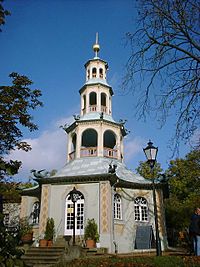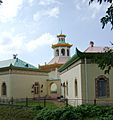Chinoiserie facts for kids
Chinoiserie refers to elements in European art that are influenced by Chinese arts. Some of the most prominent examples of Chinoiserie can be found in royal palaces in Europe, such as the Drottningholm Palace in Sweden and Tsarskoye Selo in Russia.
Images for kids
-
Sir William Chambers' Great Pagoda at the Royal Botanic Gardens at Kew, London
-
The Chinese Garden, a chinoiserie painting by François Boucher; 1742; oil on canvas; 40.5 x 48 cm
-
Man seated on plinth, holding monkey and ball. Meissen porcelain. Dated circa 1735. British Museum.
-
The Chinese House in Potsdam (Germany)
-
The "Chinese Village" at Tsarskoe Selo, commissioned by Catherine the Great
-
The "Chinese Palace" in Palermo, commissioned by Ferdinand III of Sicily
-
Tea House at Myasnitskaya Street in Moscow
-
Cuboid vase; circa 1870; bone china; 20.8 × 10.2 × 10 cm; Metropolitan Museum of Art (New York City)
-
Wall clock; circa 1880; bronze and enamel; probably made by Escalier de Cristal (Paris); Art Institute of Chicago (US)
-
A Medici porcelain bottle; 1575-1787; Louvre. The Casino of San Marco's porcelain manufactory was one of the oldest successful attempts to imitate Chinese porcelain in European history.
-
Austrian coffeepot; circa 1720; hard-paste porcelain; 17.8 × 15.9 cm; Metropolitan Museum of Art (New York City)
See also
 In Spanish: Chinería para niños
In Spanish: Chinería para niños



















